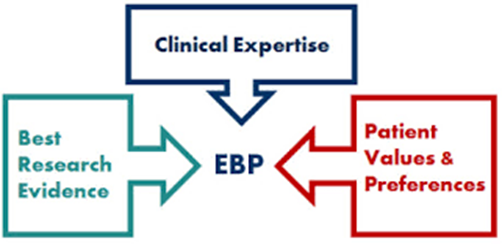Which institution-specific clinical practice resource will the nurse use to integrate evidence- based practice (EBP) into the care of a client hospitalized for the purpose of the evaluation of his or her current therapy plan?
Using a clinical algorithm in the form of a decision tree to review treatment approaches
Reviewing decision points for therapy planning provided by clinical practice guidelines
Researching current medication options using Internet resources
Implementing a clinical pathway to provide expected outcomes using a measurable format
The Correct Answer is B
A. Clinical algorithms help in standardizing certain processes but might not specifically integrate evidence-based practice guidelines for evaluating therapy plans.
B. Clinical practice guidelines offer evidence-based recommendations, aiding healthcare providers in decision-making for specific conditions or treatments.
C. While the internet may provide information, it might lack the vetting and credibility of evidence-based practice guidelines provided by reputable sources.
D. Clinical pathways provide a structured approach to care delivery but might not inherently integrate evidence-based practice guidelines unless these are explicitly incorporated into the pathway.

Nursing Test Bank
Naxlex Comprehensive Predictor Exams
Related Questions
Correct Answer is C
Explanation
A. While assessing the impact of a suicide attempt on others is important, the immediate focus following a successful suicide attempt in a mental health unit is to ensure the safety of all clients.
B. Restricting group therapy for 72 hours might impede the therapeutic process and does not directly address the safety of clients after a suicide attempt.
C. Following a suicide attempt, it's standard practice to heighten monitoring and implement suicide precautions for all clients to ensure their safety.
D. While assessing the situation is important, immediate intervention to prevent further harm to other clients is a priority following a suicide attempt. The psychological assessment might occur but would not be the primary intervention in this immediate crisis situation.
Correct Answer is B
Explanation
A. Being married might have protective factors against depression for some individuals due to social support; however, it's not universally a risk factor.
B. Chronic illness, due to its impact on quality of life, pain, and coping mechanisms, is a well-known risk factor for developing depression.
C. While depression can affect anyone regardless of gender, it's not accurate to label male gender as a risk factor in itself.
D. Pregnancy can be associated with perinatal mood disorders like postpartum depression, but it's not a universal risk factor for depression in all cases.

Whether you are a student looking to ace your exams or a practicing nurse seeking to enhance your expertise , our nursing education contents will empower you with the confidence and competence to make a difference in the lives of patients and become a respected leader in the healthcare field.
Visit Naxlex, invest in your future and unlock endless possibilities with our unparalleled nursing education contents today
Report Wrong Answer on the Current Question
Do you disagree with the answer? If yes, what is your expected answer? Explain.
Kindly be descriptive with the issue you are facing.
